Guess what, everyone—there’s a new Star Wars movie that’s open in theaters! I know, right? It’s unbelievable that you haven’t heard of such a thing. We live to break the cutting-edge news here at GeeklyInc.
In the spirit of GET HYPE, I wanted to review two recent Star Wars tabletop offerings that I’ve been seeing around my game store: Star Wars: Armada and Star Wars: Imperial Assault. Both are produced by Fantasy Flight Games, and each one invites players to live out their childhood (or adulthood) fantasy Star Wars battles.
A conceptual sequel of sorts to Fantasy Flight’s X-Wing Miniatures series, Star Wars: Armada is a tactical miniatures game that lets players conduct their very own grand space combat. As in X-Wing, Armada battles take place on an open spacefield (no gridlines or spaces), usually 3 feet by 6 feet. Each player commands a fleet of several capital ships (and often a number of fighter squadrons); players take turns issuing orders to their fleet, trying to attack and outmaneuver their opponent’s ships.
TL;DR: It’s a game where you get to play with Star Wars ships. How much convincing do you really need?

I didn’t need much incentive myself, so last weekend I happened down to my Friendly Local Gaming Store—Pandemonium Books and Games in Cambridge, MA—for their Star Wars: Armada Wave 2 celebration tourney. I was lucky to have a friend who had extra fleets he was willing to lend, as I got to play two very different games.
First up—Star Wars: Armada is a very attractive game. This makes a lot of sense; after all, the big draw to the game is you get to play with Star Wars ships—but does deserve mention how detailed the models are. The capital ships come pre-painted, and the overall effect is quite striking. The miniature ships feel sturdy (although you’d naturally want to take good care of them), and each comes with a custom-designed mount to keep it floating above the gamepiece’s base.
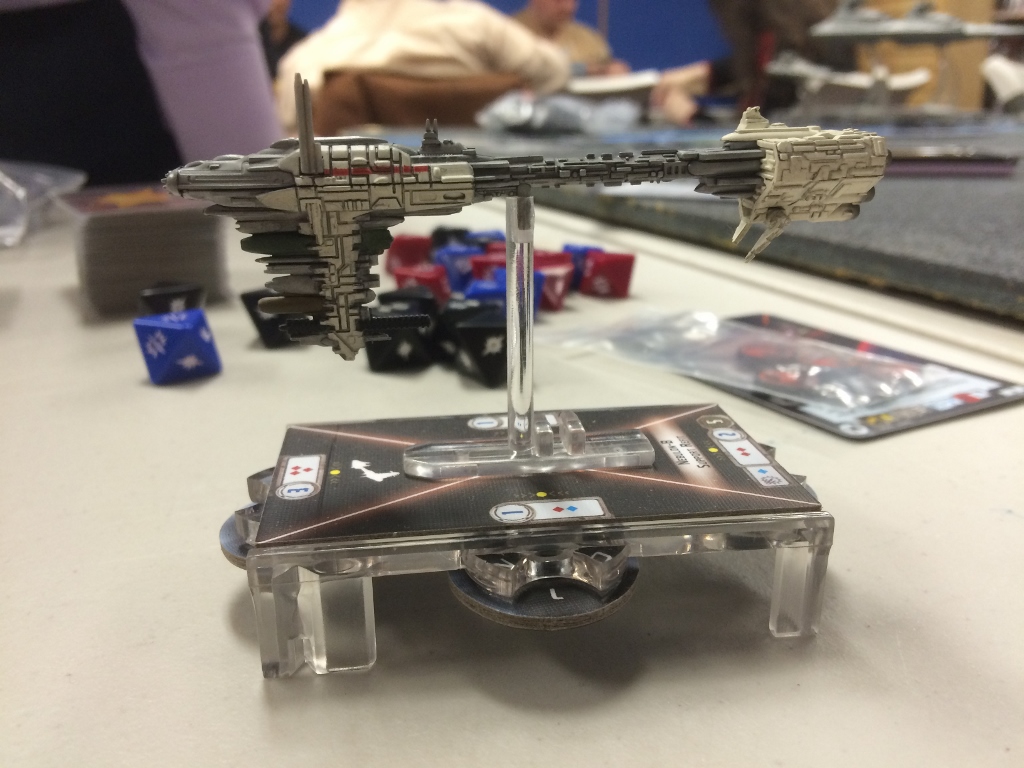
The Nebulon-B-class Frigate model.
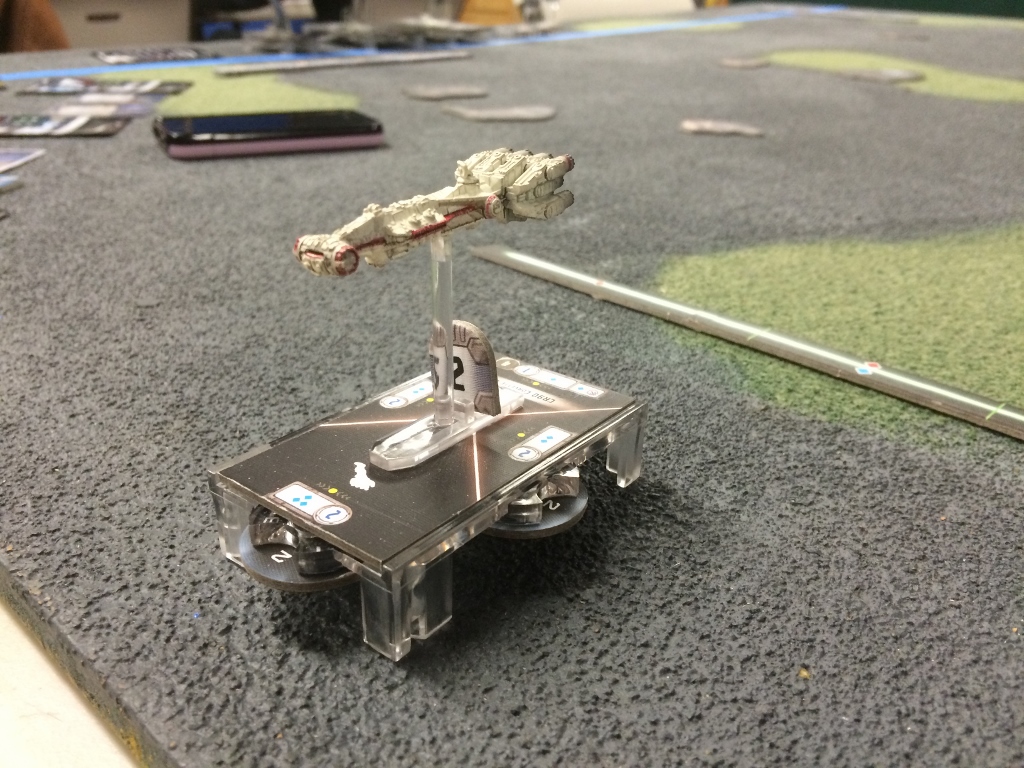
The Corellian Corvette model.
The ships are built to a relative scale, so your Star Destroyers really do tower over the smaller rebel ships. As you can see, they make for impressive visuals, even when you mess up the photograph so that everything comes out slightly blurry.
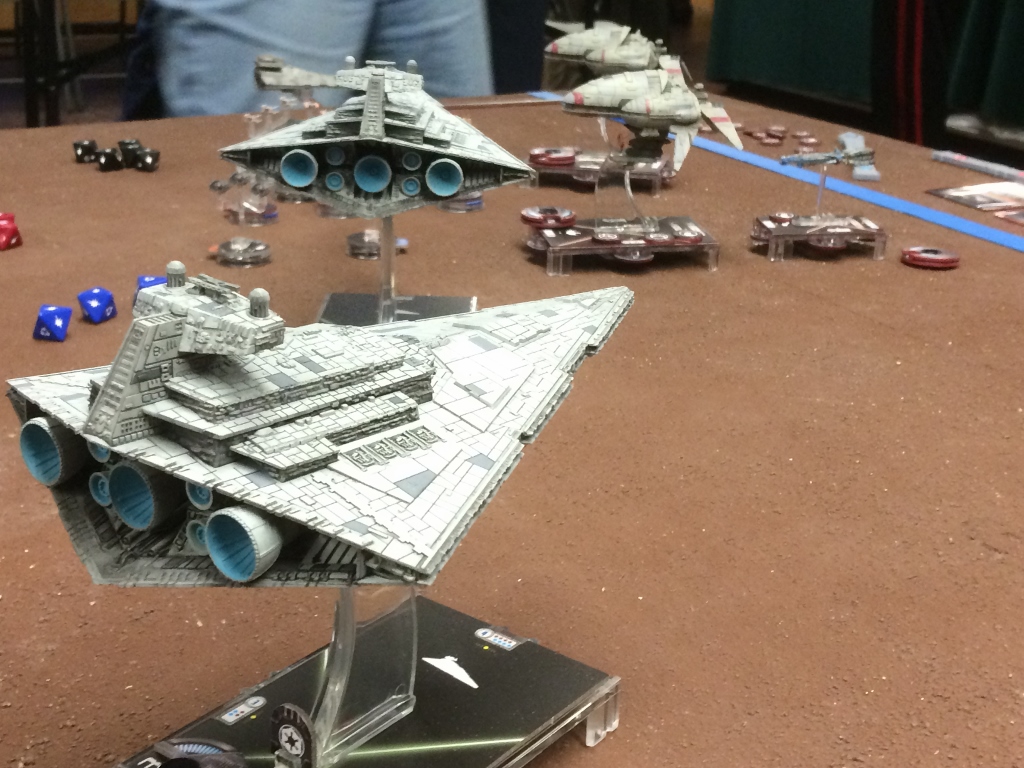
 That plastic base provides some reference information—shields, weapons, and so forth—but each model also corresponds to a card which describes its play stats. Here’s where you look to see how fast the ship can go, how many hits it can take, and so on. These cards are double-sided, with each side slightly different, and you can pick which you prefer as you build up your fleet; the Imperial II-class, pictured here, has better weapons than the Imperial I-class, but costs more fleet points. Normal competitive play allows for fleets of up to 400 points, but between friends you can agree on whatever you like. You might even try handicapping one player, if you have a noticeable skill gap.
That plastic base provides some reference information—shields, weapons, and so forth—but each model also corresponds to a card which describes its play stats. Here’s where you look to see how fast the ship can go, how many hits it can take, and so on. These cards are double-sided, with each side slightly different, and you can pick which you prefer as you build up your fleet; the Imperial II-class, pictured here, has better weapons than the Imperial I-class, but costs more fleet points. Normal competitive play allows for fleets of up to 400 points, but between friends you can agree on whatever you like. You might even try handicapping one player, if you have a noticeable skill gap.
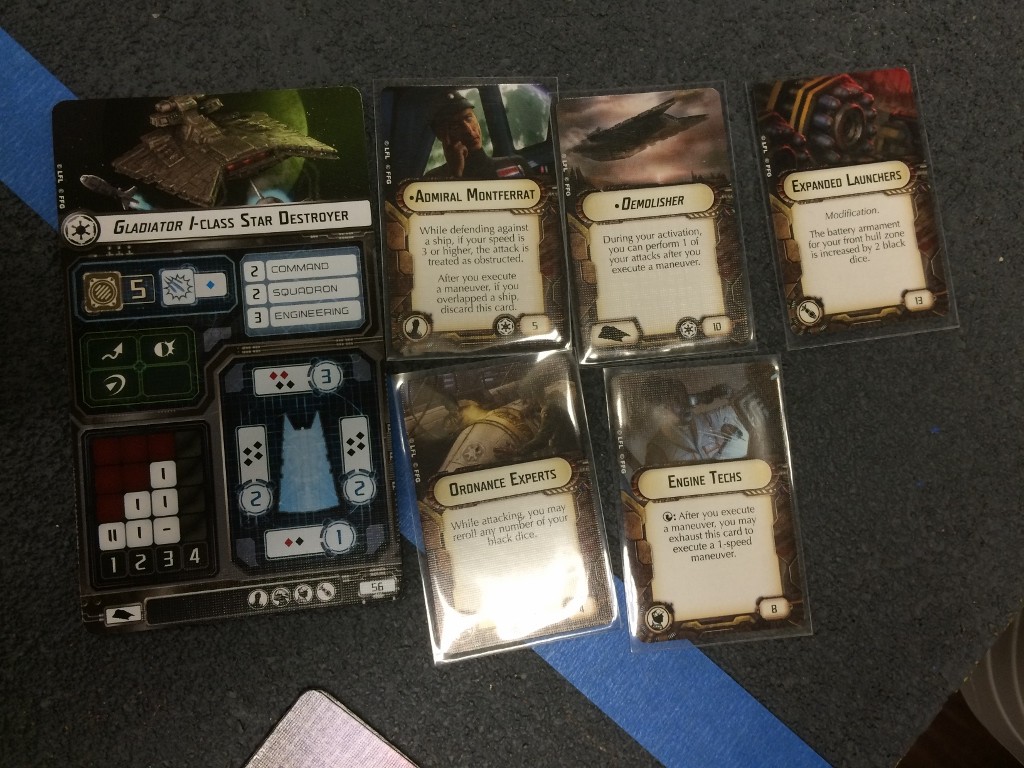
You can also spend fleet points to add modifications to the individual ships in your fleet. In one game, I got to fly this tricked-out Gladiator-class Star Destroyer. It had extra movement, extra attack dice, free rerolls, and more. As you can see, some of these cards represent upgraded ordinance, engines, or crew. Other cards add a commander to your ship, or designate it as a unique ship from the expanded universe. These extra mods aren’t free—they cost almost as many fleet points as the ship itself—but they turned this particular Gladiator into a merciless death engine, one that could close distance quickly and blast its forward batteries like a sawed-off shotgun.
This level of customization is one of the most exciting parts of the game, particularly to me, as a beginning player. While there are (currently) only a dozen or so units on each side (including squadrons, bounty hunters, and ships like the Millenium Falcon), you can still mod out your ships so that each one feels different, even if it looks just like a ship you already know. It feels like there are lots of possibilities, which in turn evokes a large universe waiting to be explored.
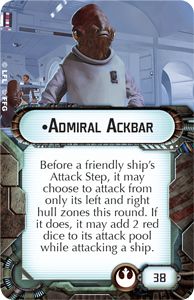
Pictured: not a trap.
Players also add commander cards to their fleets, who give an overall bonus to each ship, and who can therefore guide an overall strategy. Some of these are pretty flavorful: Admiral Ackbar, for example, gives ships exceptional broadside firing power. I later learned that in the expanded universe, Ackbar is known for the Ackbar Slash, a maneuver in which Rebel ships knife between larger Imperial cruisers—pretty much exactly what you want to do if Ackbar is commanding your fleet.
Strategic and tactical decisions within each game are further influenced by mission cards. Each player brings several mission cards to each session; you can select your own cards to play to the strengths of your fleet, though you never know what missions your opponent might have. In my first game, our mission card awarded bonus points for scoring hits against the rear shields of my opponent’s ships, which drove my entire strategy. This went poorly, as it happened, because I misjudged the range and power of my friend’s Ackbar broadsides, and several of my ships got crushed to dust early in the battle. Still, it was nice to have a clear goal for my first outing, and I’d imagine that more experienced players would appreciate the variety, especially if they get used to seeing their friend’s same fleet again and again.

Pictured: My Corellian Corvette (center), moments before being vaporized by an MC30c Torpedo Frigate (center left). Oops.
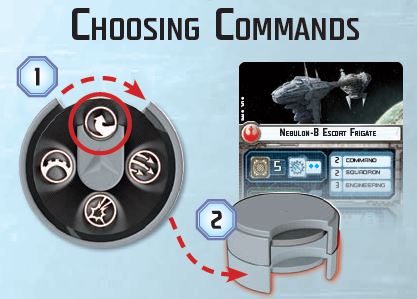 The actual gameplay is pretty straightforward, in spite of the overall strategic complexity. Each round, players take turns activating their ships, one at a time. Ships shoot first, if they are in range to attack anyone, and then move.
The actual gameplay is pretty straightforward, in spite of the overall strategic complexity. Each round, players take turns activating their ships, one at a time. Ships shoot first, if they are in range to attack anyone, and then move.
Specific commands are given through command dials, another innovative feature of the game. As seen in the diagram (snipped from FFG’s “Learn to Play” PDF), each dial has four options: maneuver, activate fighter squadrons, focus fire, and engineering (i.e., repair). Commands dials are set ahead of time, then stacked together, and each ship resolves its topmost command dial each turn. (At the end of the turn, you choose a new command and set the dial on the bottom of the stack.) Command dials require some amount of thinking ahead—you need to be able to predict where each ship will be and what will be most beneficial for it to do several turns from now. Luckily, if you don’t wind up really needing action on the top command dial, you get a token which you can cash in for a lesser effect on a future turn. Tokens do good work of ensuring you don’t get too hosed by picking the wrong action several turns in advance.
All this does a really excellent job of capturing the feeling of commanding a capital-class starcruiser. Larger ships like Star Destroyers are less responsive, and not just in their speed and maneuverability—your commands actually take longer to relay through the ship. Compared to a tiny blockade runner like the Corellian Corvette (which only has one command dial, so it can do exactly what it needs every turn), the difference is noticeable. The command dials aren’t cumbersome, but they do require foresight; when your ship can adapt quickly, it’s a welcome luxury.
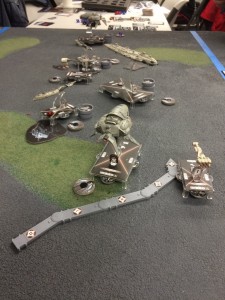
Using the maneuver tool to complete a movement.

Lining up a shot with the targeting tool.
Meanwhile, spatial relations between the various ships are governed by a set of included distance measures and maneuver tools. These work reasonably well—I found it interesting how ships’ speeds affect how many clicks of articulation you can use on the maneuver tool—though they’re a bit fiddly, and some questions of targeting and distance come down to arguable judgment calls. This is no issue if you’re playing friendly games; if you keep a convivial, collaborative atmosphere, both players share the work of making sure rules are observed and can resolve disputes by, say, doing the awesomest thing, which feels like it’s in the spirit of the game. I could see it being a point of dispute in competitive play, where accidentally nudging a figure as you set the maneuver tool against it could materially affect targeting range. (Fantasy Flight does support an organized play program, including a World Championships, held this November at the Fantasy Flight Games Center in lovely Roseville, MN. I wasn’t able to find any information about the winners, and I haven’t witnessed a match played truly competitively, so I can’t say this is definitely an issue, only potentially.)
Of course, Star Wars: Armada is a Fantasy Flight game, which means the rules have a fair bit of complexity—as you might expect, they tend toward “reality simulation” more than pure “game action.” My description here excludes some of the tactical texture of attacking and defending, which includes defense tokens a player can spend to minimize damage effects, as well as various colors of dice with various effects (including negating damage tokens). There’s no shortage of decisions to make, and they all feel like they matter. But despite this complexity, play proceeds fairly quickly, since you’re only ever focusing on one thing at a time.
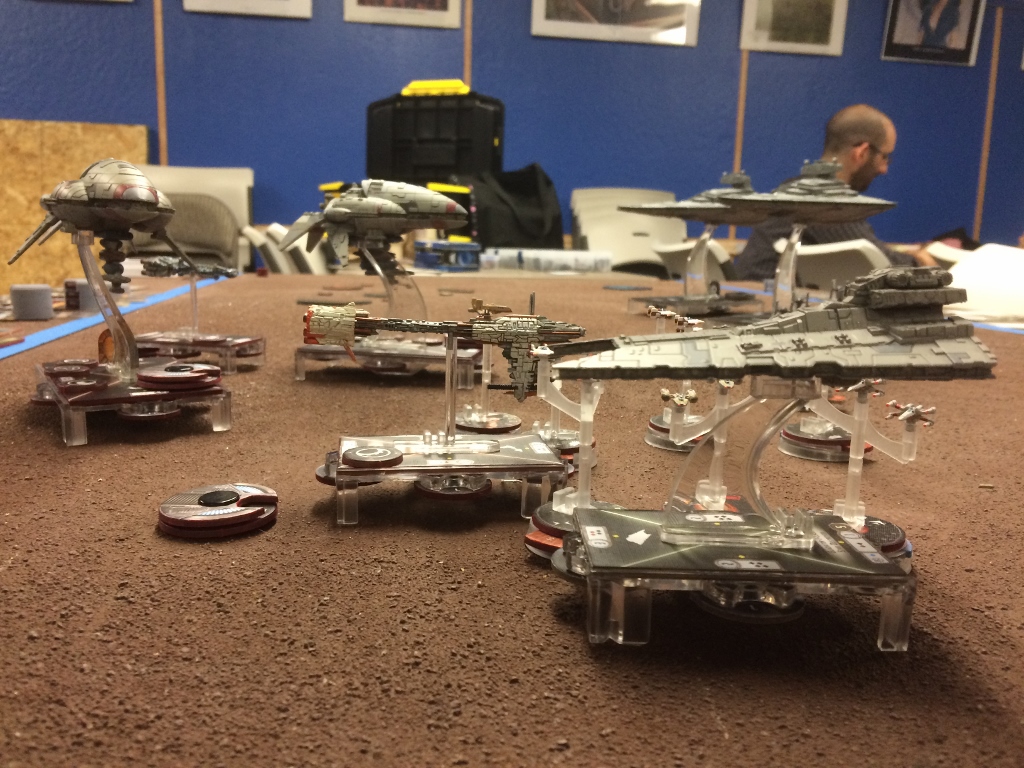
The game’s not perfect, of course. In particular, the set-up can be a bit time-consuming: each player demarcates a “deployment zone,” then places obstacles, then ships, then sets command dials and initial speeds, and, after all that, the first turn is often just movement. That said, when the action starts, it gets fairly intense; in particular, firing a full volley at an enemy ship is an exciting pay off for a few turns of setup and planning. There also isn’t anything in the way of a catch-up mechanic—not that one would really make sense—but if you get several ships dusted right away (ahem), it may make more sense to concede than to run out the full six rounds. Again, being a good sport and enjoying the sheer coolness of a space battle goes a long way here.
Finally, a word on cost. Tactical minis games tend to run pricey, and Armada doesn’t exactly buck the trend. Depending on where you shop, the base set can run around $100 MSRP, and subsequent expansions range from $20 (for several fighter squadrons or a small ship) to $50 (for a large ship like a Star Destroyer). There are good deals to be had, if you look around—though, as ever, please support your local gaming stores, since they need to keep the lights on.
Fielding a 300- or 400-point fleet could reasonably cost $100–$150, maybe $200 at the high end. That’s a sizable outlay, but you get a good amount of bang for your buck: the models, which are gorgeous, plus all the cards you need to modify them as (or if) you choose. (See this preview of the MC30c Frigate for the full spread you get with a $30 MSRP expansion pack.) When considered against other hobbies (i.e., I’m a Magic player), it doesn’t seem so bad—a competitive Magic deck, for example, might run into the high hundreds, and even a draft every week will set you back $50–$60 per month. A few new video games a month could be $120 pretty easily. So, if you share the cost with a few friends, and get together to play regularly, the cost is pretty justifiable. Plus, if you play with a group, you can start small (with the base set) and add models as you’re able, and as you desire.
The models themselves are produced in China, which helps to keep the costs down, but introduces some other ethical questions (which, naturally, many other games also encounter). For what it’s worth, my game-store-employee friend mentioned that Fantasy Flight had recently encountered some delays in production—in part because they were doing their best to ensure that working conditions in factories they source from remain at a certain standard.
All told, Star Wars: Armada is the grown-up version of the epic battles you’d have with your Lego sets when you were a kid: exciting ships, daring tactics, with a little luck thrown in for drama. The game gives a ruleset for playing out the sortie and a substantial number of ways to customize your fleet and each of the ships in it. In spite of some finicky rules, the game moves quickly, and as long as “fun” is your main goal, the movement tool and targeting stick don’t feel too ticky-tacky. Just exploring the various strategies could take a dedicated playgroup a substantial amount of time, and the game’s mission cards will add variety of top of that. The cost of the models is a barrier, but a dedicated group can defray that—plus, more friends means you play more often.
Plus, wouldn’t it be fun to say “It’s a trap!” in context one time? Just a thought, internet.
Pros: Attractive, detailed models; several innovative game mechanics and devices; lots of options for customization; playing out Star Wars space battles.
Cons: Somewhat fiddly targeting and movement; set-up can be time-consuming; initial cost to entry higher than traditional board games.
[Images in this article are the author’s own photographs or captures from the Fantasy Flight “Star Wars: Armada: Learn to Play PDF.]
